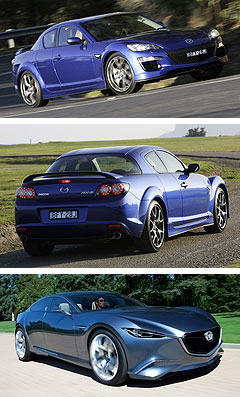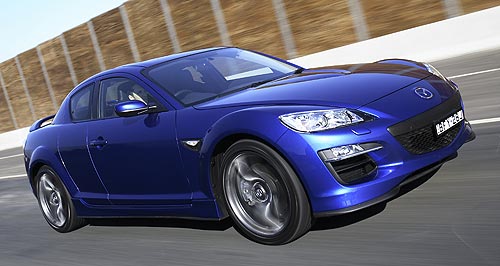Make / Model Search
Future models - Mazda - RX-9Rotary necessary for our future – Mazda chiefHeart transplant: The RX-8 successor is the likely candidate for Mazda's new, more efficient rotary engine. Mazda commits to next-generation rotary in preparation for hydrogen society19 Oct 2010 MAZDA has re-affirmed its commitment to the brand’s trademark rotary engine technology, this time for personal reasons from the very top. Speaking in Sydney the day before Mazda’s all-new BT-50 utility made its global debut at the Australian International Motor Show on Friday, Mazda Motor Corporation president and CEO Takashi Yamanouchi said the rotary engine was one of the driving reasons he joined the resurgent Japanese car-maker 43 years ago. “As we speak we’re developing the next-generation rotary engine,” he said. “I joined Mazda in 1967 when the first Cosmo (rotary sportscar) was released. I joined because of (the excitement) rotary created. “Next year and every year new people will join Mazda because of the rotary engine. Many new recruits mention this. “We consider the rotary engine to be one element of our Zoom-Zoom brand, therefore we’ll continue to develop it. We like to cherish this kind of challenging spirit we’ve shown with the development of the rotary. “A (high efficiency) gasoline rotary is on its way. Please wait for it ...”  Left: Mazda RX-8. Bottom: Mazda Shinari concept. Left: Mazda RX-8. Bottom: Mazda Shinari concept.As we reported last month, Mazda has set an ambitious 50 per cent fuel consumption reduction target for its next-generation rotary engine, which will be dubbed the ‘Sky Rotary’ if it meets the same efficiency targets achieved by the company’s ground-breaking Sky G petrol engine family. In debut 2.0-litre form, the Sky G engine employs direct fuel-injection and a high 14:1 compression ratio to return average fuel economy of just 6.0L/100km. That’s the sort of efficiency Mazda has targeted for the all-new 16X in a lightweight sportscar, as part of its pledge to reduce the fuel consumption of its new-vehicle fleet by 30 per cent between 2008 and 2015. As previewed in the Taiki sports coupe concept that appeared at the 2007 Tokyo motor show, Mazda’s all-new Renesis rotary engine will feature direct fuel-injection, a lightweight aluminium side housing, two rotary cylinders with a longer stroke and larger displacement, all of which aims to “raise thermal efficiency and boost torque at all engine speeds”. Increased from 1.3 litres to 1.6, the larger, more powerful rotary engine – codenamed 16X – eventually will replace the 13B engine in the four-door RX-8 ‘coupe’ that was discontinued recently in some countries due to tighter new Euro 5 emissions restrictions. While performance and efficiency figures have not been released, the 16X will be both more powerful and economical than the 13B, which in the current RX-8 delivers 170kW (158kW in the automatic) and 211Nm of torque, but has been criticised for its V8-like 12.9L/100km (12.1L/100km for the auto) fuel consumption. The Sky rotary engine development program was confirmed to GoAuto in Germany last month by Mazda’s global R&D director Seita Kanai. In Sydney last week, Mr Yamanouchi said Mazda’s investment in the next-gen rotary would not only be offset by its appearance in at least one future sportscar, but by its application as a hydrogen-burning powerplant in models such as the RX-8 Hydrogen RE test vehicle. The global Mazda chief said rotary power was also fundamentally well suited for use as a range-extending engine-generator for hybrid vehicles like the Premacy HRE, which became available for lease in Japan last month. “The rotary engine ... is a powerplant for the petrol line, but because of its compatibility with hydrogen it has the potential to be used with hydrogen cars,” he said. “Because hydrogen supply infrastructure is limited, we are still doing research on the hydrogen car. “In the Premacy rotary hybrid ... the hydrogen is burned in the rotary engine and only water and steam is emitted. Its power is not used directly but to generate electricity, so in this sense it is an EV. “Because of these developments we consider the rotary engine to be necessary for our future. “When the hydrogen society is upon us we will sell a lot of these vehicles and recoup our investment.” If the Taiki concept’s powertrain is an accurate guide, Mazda’s all-new Renesis rotary will be available with a new seven-speed dual-clutch automated manual gearbox rather than with Mazda’s new Sky-Drive conventional six-speed automatic transmission. Of course, it remains unclear which vehicle the 16X will debut in – or which model(s) it could also eventually power. Mazda recently signed off the investment in its fourth-generation MX-5 roadster, but a more likely candidate is expected to be the replacement for the RX-8, which was launched in Australia in 2003. Beyond that, a more focussed two-seat successor for the long-lamented RX-7 coupe has been consistently called for by Mazda fans and even executives within the company itself, mostly recently including design chief Ikou Maeda – son of original RX-7 designer Matasaburo Maeda – who described a new RX-7 as his dream. During a visit to Melbourne in April, Mazda’s global sales, marketing and customer service boss, Masazumi Wakayama, told GoAuto that his company’s resources would not allow the development of a third sportscar beyond the MX-5 and RX-8. Whether Mazda decides to release a top-shelf sportscar, GoAuto understands it is highly unlikely to wear the iconic RX-7 badge, which Mazda insiders say will be preserved in history rather than being potentially tarnished by an inevitably heavier, larger successor. Indeed, if it eventuates and Mr Maeda gets his way, expect the born-again RX-7 to borrow design cues from the striking Shinari, and to be “much more serious” than both the 1978 original and the upcoming FT-86 concept-based sports coupes from Toyota and Subaru.  Read more7th of September 2010  Mazda 'Sky Rotary' locked inRotary power on the way ... and RX-7 firmly on Mazda designer's wishlist too31st of August 2010  First look: Shinari concept heralds new Mazda lookMazda reveals new ‘Kodo’ design direction in the shape of stunning Shinari conceptAll future models Alfa Romeo Alfa Romeo Abarth Abarth Alpine Alpine Alpina Alpina Audi Audi Aston Martin Aston Martin BMW BMW Bentley Bentley Chery Chery Brabham Brabham Chrysler Chrysler Chevrolet Chevrolet Cupra Cupra Citroen Citroen DS DS Dodge Dodge Fiat Fiat Ferrari Ferrari Foton Foton Ford Ford Great Wall Great Wall FPV FPV Haval Haval GWM GWM Honda Honda Holden Holden Hummer Hummer HSV HSV Infiniti Infiniti Hyundai Hyundai Jaguar Jaguar Isuzu Isuzu Kia Kia Jeep Jeep Land Rover Land Rover Lamborghini Lamborghini Lexus Lexus LDV LDV Mahindra Mahindra Lotus Lotus Mazda Mazda Maserati Maserati Mercedes-AMG Mercedes-AMG McLaren McLaren MG MG Mercedes-Benz Mercedes-Benz Mitsubishi Mitsubishi Mini Mini Opel Opel Nissan Nissan Peugeot Peugeot Pagani Pagani Proton Proton Porsche Porsche Renault Renault Ram Ram Rover Rover Rolls-Royce Rolls-Royce Skoda Skoda Saab Saab SsangYong SsangYong Smart Smart Suzuki Suzuki Subaru Subaru Toyota Toyota Tesla Tesla Volvo VolvoMotor industry news |
Click to shareMazda modelsResearch Mazda All future models Alfa Romeo Alfa Romeo Abarth Abarth Alpine Alpine Alpina Alpina Audi Audi Aston Martin Aston Martin BMW BMW Bentley Bentley Chery Chery Brabham Brabham Chrysler Chrysler Chevrolet Chevrolet Cupra Cupra Citroen Citroen DS DS Dodge Dodge Fiat Fiat Ferrari Ferrari Foton Foton Ford Ford Great Wall Great Wall FPV FPV Haval Haval GWM GWM Honda Honda Holden Holden Hummer Hummer HSV HSV Infiniti Infiniti Hyundai Hyundai Jaguar Jaguar Isuzu Isuzu Kia Kia Jeep Jeep Land Rover Land Rover Lamborghini Lamborghini Lexus Lexus LDV LDV Mahindra Mahindra Lotus Lotus Mazda Mazda Maserati Maserati Mercedes-AMG Mercedes-AMG McLaren McLaren MG MG Mercedes-Benz Mercedes-Benz Mitsubishi Mitsubishi Mini Mini Opel Opel Nissan Nissan Peugeot Peugeot Pagani Pagani Proton Proton Porsche Porsche Renault Renault Ram Ram Rover Rover Rolls-Royce Rolls-Royce Skoda Skoda Saab Saab SsangYong SsangYong Smart Smart Suzuki Suzuki Subaru Subaru Toyota Toyota Tesla Tesla Volvo VolvoMotor industry news |











Facebook Twitter Instagram